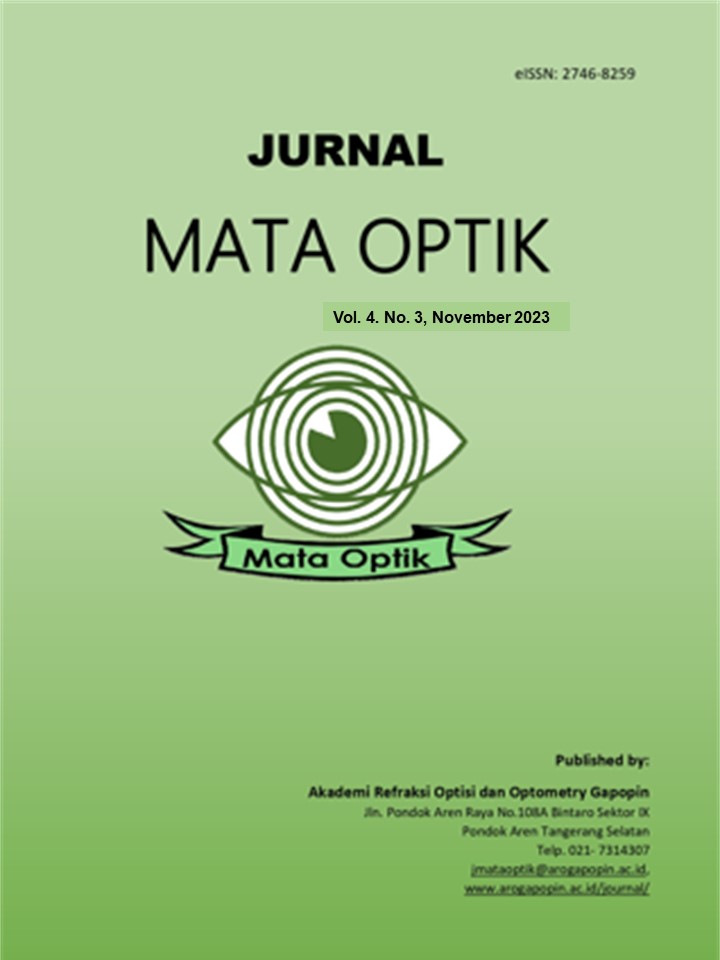GAMBARAN BESAR KELAINAN REFRAKSI ASTIGMATISME PADA ANAK USIA DINI DI PASIR JAYA TAHUN 2022
DOI:
https://doi.org/10.54363/jmo.v4i3.180Keywords:
: astigmatism, , early childhood, , eye healthAbstract
This study focuses on how the eye conditions of children suffering from astigmatime are in the Pasirjaya housing complex. The purpose of this research is to provide education about the importance of maintaining eye health. To provide an understanding of astigmatism. To provide knowledge on how to treat astigmatism so that it can be overcome. The research method used in this study is a qualitative method (by developing why atigmatism in children can occur and the factors that can cause astigmatism in children). This study resulted in the findings that patients know about Astigmatism in children as much as 61.7%. It was found that they had astigmatism, while the others had other refractive errors. This was due to the prolonged use of gadgets in carrying out online activities or also known as online. while those who understand the dangers of astigmatism are left at 60.7% so they do protection with astigmatism correction lenses. So that parents especially have to be introspective in seeing the development of children during this pandemic season by monitoring the use of laptops or gadgets in their daily processes by instilling the 20/20/20 theory
References
Budiono, S. (2019). Buku Ajar Ilmu Kesehatan Mata. Airlangga University Press.
Fauzi, L. (2016). Skrining Kelainan Refraksi Mata Pada Siswa Sekolah Dasar Menurut Tanda Dan Gejala. JHE (Journal of Health Education), 1(1).
Febriany, Y. E., & Arimadyo S, A. K. Dhanardhono, T. (2015). Faktor Risiko Miopia pada Mahasiswa Fakultas Kedokteran Universitas Diponegoro Angkatan 2011-2014.
Gunawan, I. (2013). Metode penelitian kualitatif. Bumi Aksara.
Indrakila, S., Soetrisno, S., Moelya, A. G., Nugroho, H. W., & Nurinasari, H. (2021). Pemeriksaan Kelainan Refraksi. JURNAL KREATIVITAS PENGABDIAN KEPADA MASYARAKAT (PKM), 4(4), 1002–1007.
Juanarta, P., & Sirait, S. N. (2021). Karakteristik Pasien Miopia Di Poli Refraksi, Lensa Kontak, Dan Low Vision Pusat Mata Nasional Rumah Sakit Mata Cicendo Periode Januari–Desember Tahun 2020. Artikel Departemen Ilmu Kesehatan Mata Fakultas Kedokteran Universitas Padjadjaran Pusat Mata Nasional Rumah Sakit Mata Cicendo.
Kalangi, W., Rares, L., & Sumual, V. (2016). Kelainan Refraksi Di Poliklinik Mata Rsup Prof. Dr. RD Kandou Manado Periode Juli 2014-Juli 2016. JKK (Jurnal Kedokteran Klinik), 1(1), 83–91.
Kanski, J. J., & Bowling, B. (2009). Corneal and refractive surgery. Clinical Ophthalmology: A Synopsis.
Kheirkhah, A., Safi, H., Molaei, S., Nazari, R., Behrouz, M. J., & Raju, V. K. (2012). Effects of pterygium surgery on front and back corneal astigmatism. Canadian Journal of Ophthalmology, 47(5).
Komariah, C. (2014). Hubungan status refraksi, dengan kebiasaan membaca, aktivitas di depan komputer, dan status refraksi orang tua pada anak usia sekolah dasar. Jurnal Kedokteran Brawijaya.
Kustiawan, U. (2016). Pengembangan media pembelajaran anak usia dini. Gunung Samudera.
Lestari, K. D., Handayani, T. A., Pemayun, C. I. D., & Manuaba, I. B. P. (2019). Karakteristik dan perbedaan kelainan refraksi pada anak usia sekolah dasar di Sekolah Dasar Cipta Dharma Denpasar Februari 2014. Mediciana, 50, 220–225.
Martono, N. (2019). Metode penelitian kuantitatif.
Mutiah, D. (2015). Psikologi bermain anak usia dini. Kencana.
Pi, L.-H., Chen, L., Liu, Q., Ke, N., Fang, J., Zhang, S., Xiao, J., Ye, W.-J., Xiong, Y., & Shi, H. (2012). Prevalence of eye diseases and causes of visual impairment in school-aged children in Western China. Journal of Epidemiology, 22(1), 37–44.
Prayoga, H. A. (2014). Intensitas Pencahayaan dan Kelainan Refraksi Mata Terhadap Kelelahan Mata. Jurnal Kesehatan Masyarakat, 9. https://journal.unnes.ac.id/nju/index.php/kemas
Prema, N. (2011). Prevalence of refractive error in school children. Indian J Sci Technol, 4(9).
Purwanto, S. (2010). Faktor determinan yang berhubungan dengan kejadian miopia. Jurnal Ilmu Kesehatan Masyarakat, 1(3).
Rahman, E. (2018). Perbandingan Pengukuran Axial Length, Anterior Chamber Depth, Lens Thickness dengan Pemeriksaan Biometri pada Anak Talasemia Beta Mayor dengan Emetropia.
Rumondor, N. E., & Rares, L. M. (2014). Hubungan kelainan refraksi dengan prestasi belajar anak di SMP Kristen Eben Haezar 2 Manado. E-Clinic, 2(1).
Saiyang, B., Rares, L. M., & Supit, W. P. (2021). Kelainan Refraksi Mata pada Anak. Medical Scope Jurnal.
Setyandriana, Y., Meida, N. S., Ikliludin, A., & Ayuputri, A. N. (2018). Hubungan Faktor Genetik dan Gaya Hidup dengan Astigmatisma pada Anak. Mutiara Medika: Jurnal Kedokteran Dan Kesehatan, 18(2).
Sofiani, A., & Santik, Y. D. P. (2016). Faktor-faktor yang mempengaruhi derajat miopia pada remaja (Studi dI SMA Negeri 2 Temanggung Kabupaten Temanggung). Unnes Journal of Public Health, 5(2), 176–185.
Son, S., Moon, J., Kang, H., Kim, Y.-J., & Lee, J. (2021). Induced astigmatism biases the orientation information represented in multivariate electroencephalogram activities. Human Brain Mapping, 42(13).
Sugiyono. (2017). Metode Penelitian Kuantitatif, Kualitatif dan R&D. Alfabeta CV.
Supit, F. (2021). Miopia: Epidemiologi dan Faktor Risiko. Cermin Dunia Kedokteran, 48(12).
Suryana, D. (2018). Pendidikan Anak Usia Dini: Stimulasi dan Aspek Perkembangan Anak.
Tumewu, S. I. (2013). Ambliopia Bilateral Disertai Eksotropia Alternans Dan Astigmatisma Miopia Kompositus. Jurnal Biomedik: JBM, 5(1).

Downloads
Published
How to Cite
Issue
Section
License
Copyright (c) 2023 Jurnal Mata Optik

This work is licensed under a Creative Commons Attribution-NonCommercial-ShareAlike 4.0 International License.





